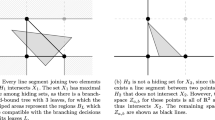Abstract
A given binary resolution proof, represented as a binary tree, is said to be minimal if the resolutions cannot be reordered to generate an irregular proof. Minimality extends Tseitin"s regularity restriction and still retains completeness. A linear-time algorithm is introduced to decide whether a given proof is minimal. This algorithm can be used by a deduction system that avoids redundancy by retaining only minimal proofs and thus lessens its reliance on subsumption, a more general but more expensive technique.
Any irregular binary resolution tree is made strictly smaller by an operation called Surgery, which runs in time linear in the size of the tree. After surgery the result proved by the new tree is nonstrictly more general than the original result and has fewer violations of the regular restriction. Furthermore, any nonminimal tree can be made irregular in linear time by an operation called Splay. Thus a combination of splaying and surgery efficiently reduces a nonminimal tree to a minimal one.
Finally, a close correspondence between clause trees, recently introduced by the authors, and binary resolution trees is established. In that sense this work provides the first linear-time algorithms that detect minimality and perform surgery on clause trees.
Similar content being viewed by others
References
Adelson-Velskii, G. M. and Landis, E. M.: An algorithm for the organization of information, Soviet Math. Dokl. 3 (1962), 1259–1263.
Chang, Chin-Liang and Char-Tung Lee, Richard: Symbolic Logic and Mechanical Theorem Proving, Academic Press, New York, 1973.
de Nivelle, Hans: Resolution games and non-liftable resolution orderings, Collegium Logicum, Ann. of the Kurt Gödel Soc. 2 (1996), 1–20.
Goerdt, Andreas: Regular resolution versus unrestricted resolution, SIAMJ. Comput. 22 (1993), 661–683.
Horton, J. D. and Spencer, B.: Clause trees: A tool for understanding and implementing resolution in automated reasoning, Artif. Intell. 92 (1997), 25–89.
Horton, J. D. and Spencer, B.: Rank/activity: A canonical form for binary resolution, in: C. Kirchner and H. Kirchner (eds), Automated Deduction-CADE-15, Lecture Notes in Artif. Intell. 1421, Springer-Verlag, Berlin, July 1998, pp. 412–426.
Horton, J. D. and Spencer, B.: Bottom up procedures to construct each minimal clause tree once, Technical Report TR97-115, Faculty of Computer Science, University of New Brunwsick, PO Box 4400, Fredericton, New Brunswick, Canada, 1997.
Kleene, S.: On the permutability of inferences, Memoirs of the AMS 10 (1952), 1–26.
Loveland, Donald:Mechanical theorem proving by model elimination, J. ACM 15 (1968), 236–251.
McCune, W. W.: Otter 3.0 users guide, Technical Report ANL-94/6, Mathematics and Computer Science Division, Argonne National Laboratory, Argonne, IL, 1994.
Letz, R., Mayr, K. and Goller, C.: Controlled integration of the cut rule into connection tableau calculi, J. Automated Reasoning 13 (1994), 297–337.
Robinson, J. A.: A machine-oriented logic based on the resolution principle, J. ACM 12 (1965), 23–41.
Sleator, D. D. and Tarjan, R. E.: Self-adjusting binary search trees, J. ACM 32 (1985), 652–686.
Spencer, Bruce and Horton, J. D.: Extending the regular restriction of resolution to non-linear subdeductions, in Proceedings of the Fourteenth National Conference on Artificial Intelligence, AAAI Press/MIT Press, 1997, pp. 478–483.
Tseitin, G. S.: On the complexity of derivation in propositional calculus, in Studies in Constructive Mathematics, Seminars in Mathematics: Matematicheskii Institute, Consultants Bureau, 1969, pp. 115–125.
Author information
Authors and Affiliations
Rights and permissions
About this article
Cite this article
Spencer, B., Horton, J.D. Efficient Algorithms to Detect and Restore Minimality, an Extension of the Regular Restriction of Resolution. Journal of Automated Reasoning 25, 1–34 (2000). https://doi.org/10.1023/A:1006241826565
Issue Date:
DOI: https://doi.org/10.1023/A:1006241826565




